Thomas Lonergan –
Cahir,
Co Tipperary
It’s been a dry month in Tipperary. If more moisture doesn’t arrive in the coming weeks, crops may begin to suffer, explains Thomas.
Spring sowing was completed two weeks ago and all crops have now emerged. The earlier sown barley crops are at the three leaf stage.
With the exception of crow damage, emergence has been very good.
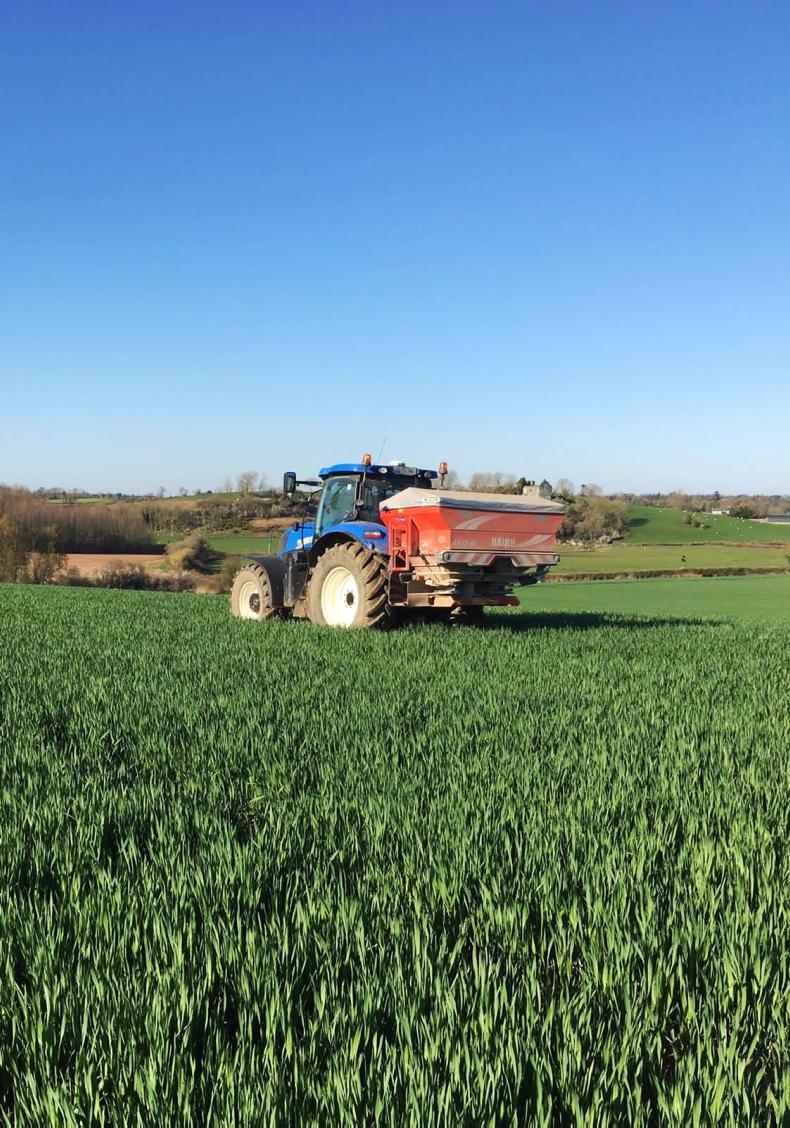
Thomas applying the final split of nitrogen onto winter oats
The barley crops have now received all of their nitrogen and stand at 156kg N/ha. The nitrogen was applied in two splits, roughly two weeks apart.
Thomas also applied liquid N (27% and 2% sulphur) onto one of the crops this year as a trial.
He intends on applying a herbicide spray at the end of this week, consisting of Boudha at 16g/ha, as well as Fluxyr 200 (0.75l/ha). He will also add an aphicide into the tank.
The cold weather has limited spraying opportunities in winter crops, says Thomas. His Belfry, Cassia and Joyau winter barley crops were being brought up to 200kg N/ha.
They also received their T1 fungicide spray consisting of Proline (0.5l/ha) and Modem (0.5l/ha), as well as the PGR’s Cycocel (1l/ha) and Moddus (0.2l/ha).
Crops are relatively clean, but he has noticed a small amount of rhynchosporium creeping in on Cassia.
Thomas’s Costello winter wheat crops were brought to 150kg N/ha last week and will be finished at 200kg N/ha next week.
They also received an application of Cycocel last week, but there was no need to apply a T0 fungicide.
He topped his hybrid winter rye up to 175kg N/ha last week.
The crops also received a T1 of Globalstar (0.8l/ha), as well as Cycocel (1.2l/ha) and Moddus (0.25l/ha).The crop will also likely receive another PGR application of Terpal next week.
Thomas explains that as this is a new crop to him, they are being very cautious. The crop is very lush and thick.
Finally, his Husky winter oats were brought up to 156kg N/ha last week. The crops also received a T1 application of Modum (0.5l/ha), Tallius (0.25l/ha), as well as Cycocel (1.2l/ha) 10 days ago.
James Robinson – Newtown-
cunningham,
Co Donegal
With over 20mm of rainfall since last week, moisture is certainly not an issue in the northwest. Night time temperatures have dipped below 1°C three times over the week, resulting in ground frosts and slowing crop growth.
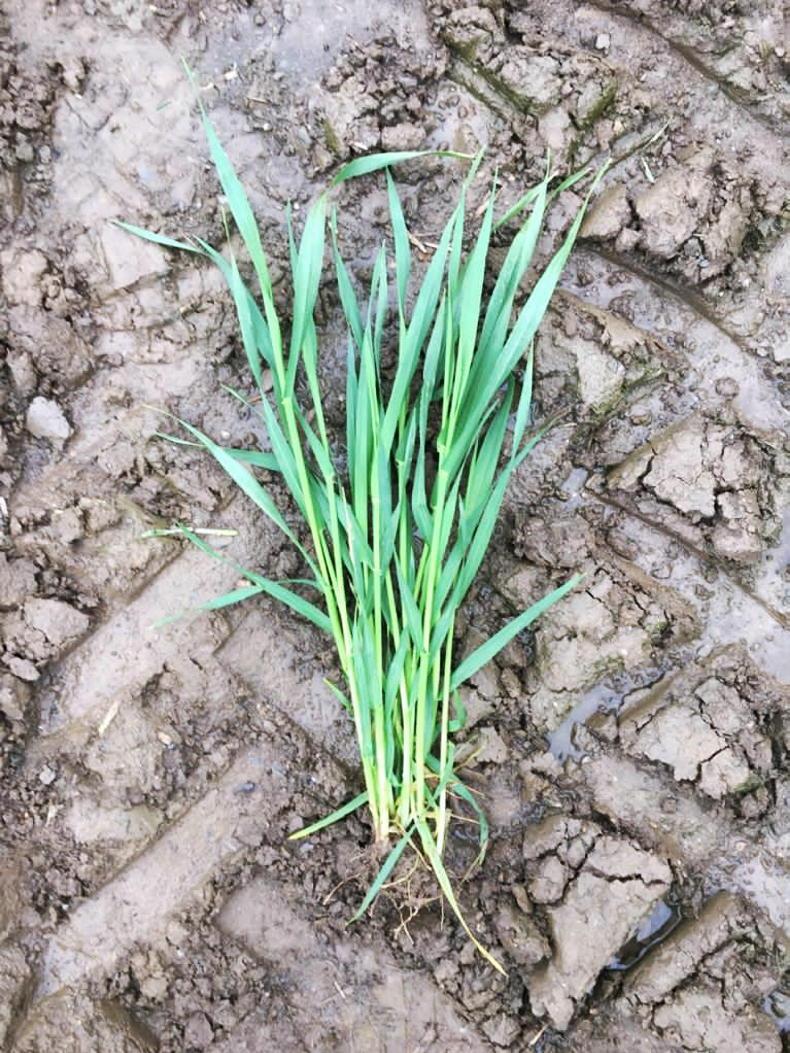
James’s Tower winter barley at GS32 this week
James is down to his last field of spring barley to drill. He decided to hold off last week, as the headland was still sticky, but hopes to get sowing by the end of this week.
He intends on sowing the spring malting barley variety Splender. The field is ploughed and he will level and apply 370kg/ha of 10:10:20 before drilling.
He may also broadcast the crop’s entire nitrogen requirement along with the seed, as it is getting late in the season.
His earlier sown spring malting barley crops are now heading for the second leaf stage.
The crops following potatoes are patchy in places, due to an amount of water logging, but crops sown into stubble are doing very well.
They received their last split of nitrogen 10 days ago, where James applied 112kg N/ha of urea (40% plus sulphur.
He aims to apply a herbicide of Cameo and Zypar, along with manganese and an aphicide when the crop gets to the third leaf stage.
James’s winter barley crops are looking good, despite the cool temperatures.
His Tower and Patriot varieties are around GS32 and last week received a T1 of Bontima (1.2l/ha) along with Corbel (0.5l/ha). Crops are clean so far.
He also added in seaweed extract Phylgreen 200 (1l/ha), Croplink 200 manganese (1l/ha), Zinc 700 (0.5l/ha) and Magflo 300 magnesium (1l/ha).
James doesn’t see the benefit of applying trace elements beyond the T1 spray in winter barley.
The crops were topped up with 40% urea and sulphur 10 days ago and now stand at 185kg N/ha. He finds this level of nitrogen is enough to achieve target yields.
James says that crops are slightly ahead when compared to last year, but once temperatures increase, they are poised for significant growth.
Tim Ronaldson – Naas,
Co Kildare
Conditions have also been dry in Kildare. Since talking to Tim last month, about 22m of rain has fallen, with around half of that in April.
The small amount of rain this week is badly needed, he explains, as the forecast looks set to remain dry.
Continued cold weather, with night time temperatures as low as minus six on the 10 and 11 April, has slowed crop growth and limited spraying opportunities, he says.

Tim rolling spring barley which was sown into ground following broccoli.
Tim finished sowing spring barley on 5 April, and wasn’t under any real pressure due to the dry weather.
His SY Errigal, Gangway, Planet and SY Arderin were sown at between 160-170kg/ha, along with 390kg/ha of 10:7:25+S.
The Gangway crop has been brought to 125kg N/ha and will likely receive another 25kg N/ha during tillering. The rest of the spring crops will be brought to 125kg N/ha this week.
His Fanfare spring beans have established well, but could do with more moisture. So far, there doesn’t seem to be much notching on the crop.
Winter barley stagnant
Tim’s winter barley crops are stagnant and in need of rain to help with fertiliser uptake. His Cassia, Belfry and Valerie crops are at around GS32 and last week received K2 (1.5l/ha) and Omex Super Mn trace elements (1.5l/ha).
The crops were clean, so he will not apply a T1 fungicide this year. The trace elements have really helped to visibly improve crop condition over the week, he explains.
Septoria
His Costello, Graham and Conros winter wheat are between GS30-31. He noted some septoria creeping in on crops, so he plans to apply a T0 of F500 (0.6l/ha) and Riza (0.5l/ha) to help tide the crop over until its T1.
Tim has also been keeping an eye out for yellow rust, but thinks the yellow tipping on his Graham crops is down to stress due to harsh weather.
His Isobel winter oats now stand at 156kg N/ha and are around the second node stage. The crop recently received K2 (1.2l/ha), Multiple (1l/ha) and Tallius (0.2l/ha).

Thomas Lonergan –
Cahir,
Co Tipperary
It’s been a dry month in Tipperary. If more moisture doesn’t arrive in the coming weeks, crops may begin to suffer, explains Thomas.
Spring sowing was completed two weeks ago and all crops have now emerged. The earlier sown barley crops are at the three leaf stage.
With the exception of crow damage, emergence has been very good.

Thomas applying the final split of nitrogen onto winter oats
The barley crops have now received all of their nitrogen and stand at 156kg N/ha. The nitrogen was applied in two splits, roughly two weeks apart.
Thomas also applied liquid N (27% and 2% sulphur) onto one of the crops this year as a trial.
He intends on applying a herbicide spray at the end of this week, consisting of Boudha at 16g/ha, as well as Fluxyr 200 (0.75l/ha). He will also add an aphicide into the tank.
The cold weather has limited spraying opportunities in winter crops, says Thomas. His Belfry, Cassia and Joyau winter barley crops were being brought up to 200kg N/ha.
They also received their T1 fungicide spray consisting of Proline (0.5l/ha) and Modem (0.5l/ha), as well as the PGR’s Cycocel (1l/ha) and Moddus (0.2l/ha).
Crops are relatively clean, but he has noticed a small amount of rhynchosporium creeping in on Cassia.
Thomas’s Costello winter wheat crops were brought to 150kg N/ha last week and will be finished at 200kg N/ha next week.
They also received an application of Cycocel last week, but there was no need to apply a T0 fungicide.
He topped his hybrid winter rye up to 175kg N/ha last week.
The crops also received a T1 of Globalstar (0.8l/ha), as well as Cycocel (1.2l/ha) and Moddus (0.25l/ha).The crop will also likely receive another PGR application of Terpal next week.
Thomas explains that as this is a new crop to him, they are being very cautious. The crop is very lush and thick.
Finally, his Husky winter oats were brought up to 156kg N/ha last week. The crops also received a T1 application of Modum (0.5l/ha), Tallius (0.25l/ha), as well as Cycocel (1.2l/ha) 10 days ago.
James Robinson – Newtown-
cunningham,
Co Donegal
With over 20mm of rainfall since last week, moisture is certainly not an issue in the northwest. Night time temperatures have dipped below 1°C three times over the week, resulting in ground frosts and slowing crop growth.

James’s Tower winter barley at GS32 this week
James is down to his last field of spring barley to drill. He decided to hold off last week, as the headland was still sticky, but hopes to get sowing by the end of this week.
He intends on sowing the spring malting barley variety Splender. The field is ploughed and he will level and apply 370kg/ha of 10:10:20 before drilling.
He may also broadcast the crop’s entire nitrogen requirement along with the seed, as it is getting late in the season.
His earlier sown spring malting barley crops are now heading for the second leaf stage.
The crops following potatoes are patchy in places, due to an amount of water logging, but crops sown into stubble are doing very well.
They received their last split of nitrogen 10 days ago, where James applied 112kg N/ha of urea (40% plus sulphur.
He aims to apply a herbicide of Cameo and Zypar, along with manganese and an aphicide when the crop gets to the third leaf stage.
James’s winter barley crops are looking good, despite the cool temperatures.
His Tower and Patriot varieties are around GS32 and last week received a T1 of Bontima (1.2l/ha) along with Corbel (0.5l/ha). Crops are clean so far.
He also added in seaweed extract Phylgreen 200 (1l/ha), Croplink 200 manganese (1l/ha), Zinc 700 (0.5l/ha) and Magflo 300 magnesium (1l/ha).
James doesn’t see the benefit of applying trace elements beyond the T1 spray in winter barley.
The crops were topped up with 40% urea and sulphur 10 days ago and now stand at 185kg N/ha. He finds this level of nitrogen is enough to achieve target yields.
James says that crops are slightly ahead when compared to last year, but once temperatures increase, they are poised for significant growth.
Tim Ronaldson – Naas,
Co Kildare
Conditions have also been dry in Kildare. Since talking to Tim last month, about 22m of rain has fallen, with around half of that in April.
The small amount of rain this week is badly needed, he explains, as the forecast looks set to remain dry.
Continued cold weather, with night time temperatures as low as minus six on the 10 and 11 April, has slowed crop growth and limited spraying opportunities, he says.

Tim rolling spring barley which was sown into ground following broccoli.
Tim finished sowing spring barley on 5 April, and wasn’t under any real pressure due to the dry weather.
His SY Errigal, Gangway, Planet and SY Arderin were sown at between 160-170kg/ha, along with 390kg/ha of 10:7:25+S.
The Gangway crop has been brought to 125kg N/ha and will likely receive another 25kg N/ha during tillering. The rest of the spring crops will be brought to 125kg N/ha this week.
His Fanfare spring beans have established well, but could do with more moisture. So far, there doesn’t seem to be much notching on the crop.
Winter barley stagnant
Tim’s winter barley crops are stagnant and in need of rain to help with fertiliser uptake. His Cassia, Belfry and Valerie crops are at around GS32 and last week received K2 (1.5l/ha) and Omex Super Mn trace elements (1.5l/ha).
The crops were clean, so he will not apply a T1 fungicide this year. The trace elements have really helped to visibly improve crop condition over the week, he explains.
Septoria
His Costello, Graham and Conros winter wheat are between GS30-31. He noted some septoria creeping in on crops, so he plans to apply a T0 of F500 (0.6l/ha) and Riza (0.5l/ha) to help tide the crop over until its T1.
Tim has also been keeping an eye out for yellow rust, but thinks the yellow tipping on his Graham crops is down to stress due to harsh weather.
His Isobel winter oats now stand at 156kg N/ha and are around the second node stage. The crop recently received K2 (1.2l/ha), Multiple (1l/ha) and Tallius (0.2l/ha).








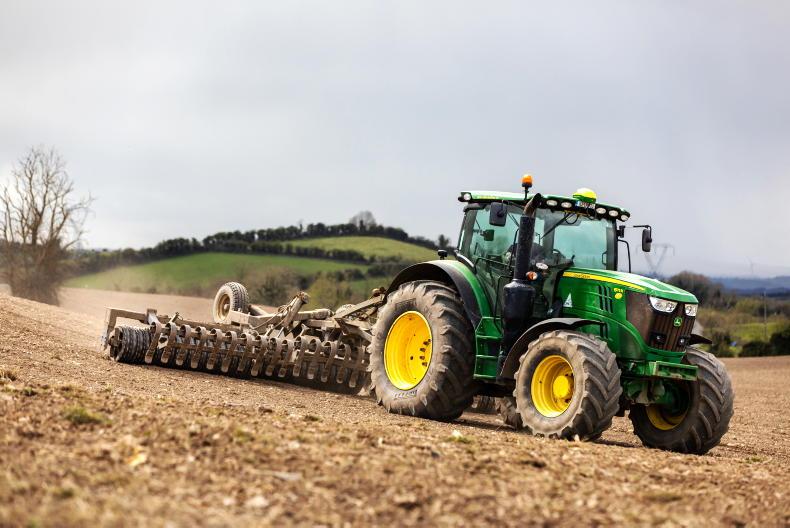


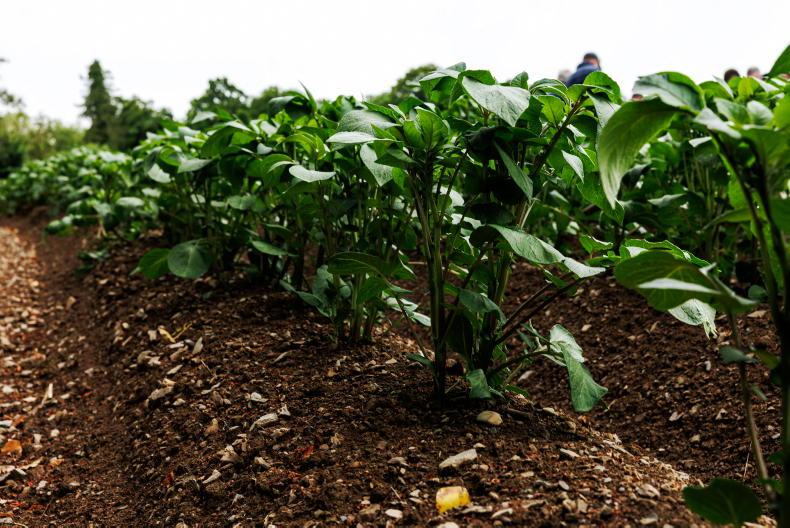
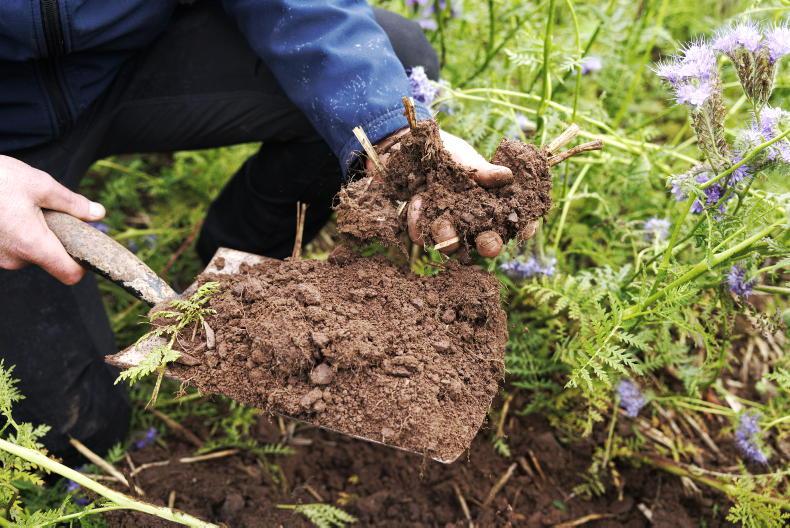
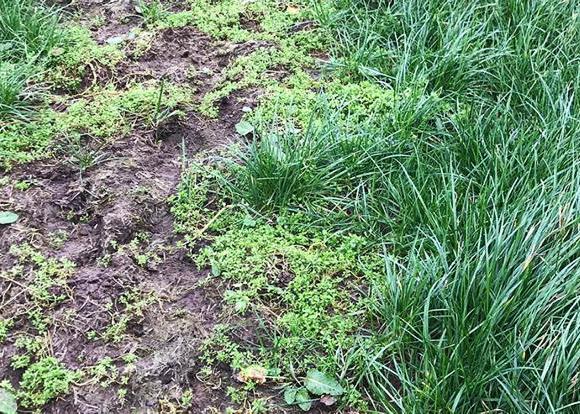
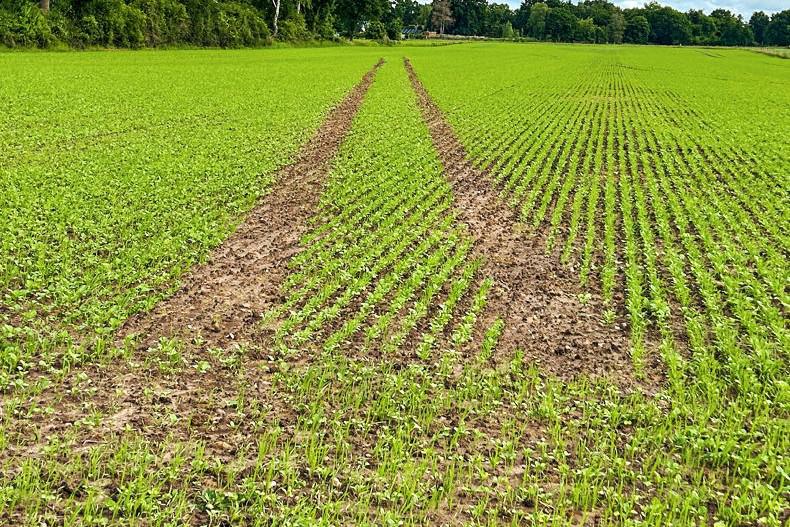
SHARING OPTIONS